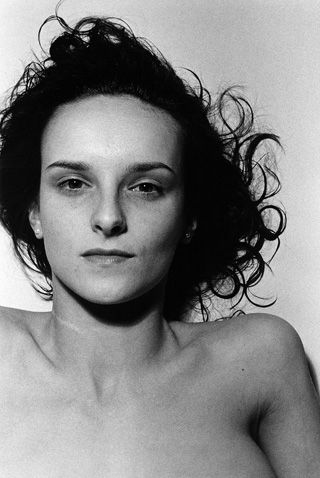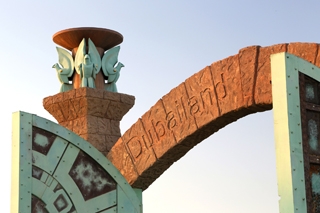Hall
Exhibition from August 30 until November 2 2014
Opening Friday 29.8 / 7 p.m.
Seiichi Furuya
>wo die wahrheit liegt<
Curated by Susanne Weiß
At the focus of Seiichi Furuya's photographic oeuvre is his personal confrontation with boundaries – boundaries of recollection, of perception and of the medium of photography, politico-geographic barriers and existential borderline situations in his own life.
The years between 1981 and 1983 saw the creation of the series “Staatsgrenze”, in which Furuya photographed the border between Austria and the Eastern Bloc states. Originating from Japan, where the border is naturally defined by the sea, he is interested in borders that lead straight through the country's middle, sometimes invisible but nevertheless separating people, cultures and ideologies from one another. While the global public concentrated mainly on the inner-German demarcation, Furuya recorded the border areas with Hungary, Yugoslavia and Czechoslovakia, thereby creating a political and at the same time personal document of contemporary history.
Seiichi Furuya moved over to the GDR with his family in 1984; he lived there until 1987. The exhibition presents a comprehensive selection of portrayals of his wife Christine, of whom he took regular portraits from 1978 until her suicide in 1985. The results are highly personal shots which, after Christine's death, he rearranged and combined in his photo books, the “Mémoires”, as a manifestation of his memories. An archive, taking on ever-changing forms, was created.
“Zu Hause in Ost-Berlin”, the third series, which can be seen at the Kunstverein, shows – like “Staatsgrenze” – images from a world which no longer exists in that form. A slide installation translates the photographs into rhythmic cross-fades and hence into a continuously changing story. The exhibition title “Wo die Wahrheit liegt” stands as a synonym of the artist's search for answers to questions to which there are no clear answers.
Seiichi Furuya (*1950 in Izu, Japan) left Japan in 1973. In 1980 he was co-founder of the magazine "Camera Austria"; today he lives and works mainly in Graz.
To accompany the exhibition the artist's book "Staatsgrenze 1981 – 1983" was published at Spector Books Leipzig in spring 2014, 30 years after the photographs' creation. The publication is available at the Kunstverein for 24 Euro.
The exhibition is taking place in partnership with Kunsthaus Dresden and the Society of Contemporary Art, Leipzig, and will be on show there in spring 2015 along with other programmatic focuses.
Studio
Exhibition from August 30 until November 2 2014
Opening Friday 29.8 / 7 p.m.
>Dubayyland<
Sophie-Therese trenka-Dalton
Curated by Susanne Weiß
In the solo exhibition “Dubayyland” Sophie-Therese Trenka-Dalton examines the staging of cultural symbols in the architecture of Dubai and the United Arab Emirates. In doing so the artist looks behind the media façade of aerial shots and 3D renderings of iconic construction projects and, progressing through objects, found items and photo works, devises an associative frame of reference between new monuments, regional motifs and (re)constructed history.
Dubai as a contemporary city is based on the increasing concentration of international capital flows, an overlapping of de-localized, conflicting life realities and the extremely accelerated expansion and conversion of urban structures. The result is an aesthetic of fragmentation and exemplariness, which Sophie-Therese Trenka-Dalton takes up as the starting point for her installation work. She interweaves miniature representations of monuments, variations of regionally significant symbols (e.g. the date palm that is a central motif for the artist's work), company logos and reconstructed architectural artefacts to form an individual reflection on a newly arising culture, in which the projecting of reality and the copying or simulating of cultural references form central components. As an extension of her specific interest in the city of Dubai the artist is currently working on the book project “Roundabout Monuments in the UAE”, on the diversity of traffic circle designs in the UAE, which will also be presented in extracts.
The exhibition “Dubayyland” in the Studio of the Heidelberger Kunstverein is the first presentation of material on architecture in Dubai, which the artist has been developing since 2009 and most recently during a four-month residential fellowship in the United Arab Emirates at the beginning of 2014.
Sophie-Therese Trenka-Dalton (*1979 in Berlin) lives and works in Berlin, where she studied at the University of Arts until 2007. Most recently the artist was awarded the Berlin Art Prize and the Global cultural exchange fellowship of the Cultural Administration of the State of Berlin in 2013.
Foyer
Exhibition from August 30 until November 2 2014
Opening Friday 29.8 / 7 p.m.
>War Porn<
christoph bangert
Curated by Stefanie Kleinsorge
Human bodies, decapitated or without limbs, tortured and thrown onto the waste tip; vegetating half-dead and massacred victims on hospital wards. Christoph Bangert has used the camera to record the abysses of human perversion. His photographs testify to presence at horrifying events in war zones, some of which the photographer himself can no longer remember.
At the beginning of the 17th and 19th century, in their graphics “The Horrors of War”, Francisco Goya and Jacques Callot deposited their testimony to the bestial sides of the power-political conflicts of their time. Christoph Bangert travelled through Palestine, Japan, Afghanistan, Iraq, Indonesia, Zimbabwe and Nigeria. Many pictures he took there have not been shown until now – because he himself thinks them too drastic or editors did not want to publish them. Bangert published extracts of this material with the book “War Porn”. It is not war photography as such that is his topic here, but rather the way the pictures are dealt with. Such brutal photographs from war zones are suppressed by the media, with the argument that showing them would be voyeuristic, pornographic, dehumanizing. However, it is the beholder's responsibility, as Susan Sontag notes in her essay on war photography of the same name, to “regard the pain of others” and thereby to acknowledge it. Occasionally it is necessary to violently and resolutely oppose self-censorship, even by wielding the paper-knife that opens the stuck pages of “War Porn”. It is necessary to find one's resolve, accept the challenge and not even once ask oneself: “Do I really want to see this?”
The book is exhibited in a locked display case and can only be browsed on request.
Christoph Bangert (*1978) studied photography at Dortmund University of Applied Sciences and at the International Center of Photography in New York. He works as a journalist and photographer, among other areas in war and crisis zones. Many of his photographs have been published in the New York Times. The publication “War Porn” was published in spring 2014 at Kehrer Verlag Heidelberg/Berlin.
Seiichi Furuya, Graz 1980 © copyright by Seiichi Furuya. Courtesy of Galerie Thomas Fischer, Berlin.
Sophie-Therese Trenka-Dalton, "Dubailand", 2014, Fotografie
Address | Heidelberger Kunstverein | Hauptstr. 97 | D-69117 Heidelberg
Mailing Adress | Heidelberger Kunstverein | Bauamtsgasse 3 I D-69117 Heidelberg
Phone | +49 6221 184086 Fax | +49 6221 164162 E-Mail | hdkv@hdkv.de
Opening Hours | Tu, We, Fr 12-19h, Thu 15-22h, Sat-Sun 11-19h

